Understand Genesis 5 Ages, number 6 details prehistory of Jewish
Ethiopians and their 364 day calendar year. Venus observers
counted 8 solar years to mark the heavenly five point star map.
Gods, kings, and calendars were metaphors found in Egyptian
mythology.
HTU_Gn5_Ages_6_Script.html
How to Understand Genesis 5 Ages 6 13:41
Holy One and 364-Day-Ethiopic-Year
Timeemits Intro.mpg 0:15
Standup Intro HTU_Gn5_Ages_6_Intro.mpg, chroma keyed against
white background, plus Title 06, Audio included 2:00
 Hi, this is How
to Understand Genesis 5 Ages, number 6 in the video series.
My name is Clark Nelson and I am going to detail the
Ethiopian religious base that was influencing early Judaism during
the Antediluvian era. Most everyone in distant prehistory
recognized an original 360-day length of year. Central
360-day calendar years are the core mainline time stream
that still exists between lunar-years and solar-years. Five days (5-days)
add with 360-days to get a typical 365-day-solar-year.
On the opposite side, lunar-years count 12-moon-months to
reach a nominal 354-day or 355-day lunar-year. Ancient
people chose whole number integer values. Lunar-years
subtract from 360-days to reveal a bisected kind of
lunar/solar year.
Hi, this is How
to Understand Genesis 5 Ages, number 6 in the video series.
My name is Clark Nelson and I am going to detail the
Ethiopian religious base that was influencing early Judaism during
the Antediluvian era. Most everyone in distant prehistory
recognized an original 360-day length of year. Central
360-day calendar years are the core mainline time stream
that still exists between lunar-years and solar-years. Five days (5-days)
add with 360-days to get a typical 365-day-solar-year.
On the opposite side, lunar-years count 12-moon-months to
reach a nominal 354-day or 355-day lunar-year. Ancient
people chose whole number integer values. Lunar-years
subtract from 360-days to reveal a bisected kind of
lunar/solar year.
Ethiopians or more loosely North Africans, went a step further by
separating solar-year remaining days and assigning them an
elevated status. Antediluvian Ethiopians devised a 364-day
calendar year that eventually spread toward Mesopotamia and
the Nile River. Four of the brightest stars were chosen to
represent the four quarters of the year. Nighttime sky was divided
into four 90-day quarters. One presiding officer star was
given paramount control over each of four 90-day quarters.
The final last 365th-day was set aside and made holy.
HTU_Gn5_Ages_6a_1.gif Exodus 20:4 Picture, Audio is
HTU_Gn5_Ages_6a.mp3 2:03
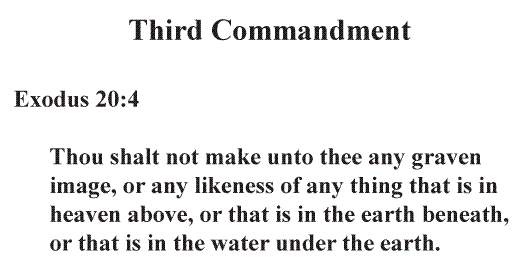 Early
indications of a single, omnipotent God overseeing
structured time is apparent. All four of the chieftain officers
were seen as angelic star presence subservient to the Holy One.
Specific instructions were given to omit the last 365th-day
from the regular length of year. Day-to-year numerical
matching might be an overwhelming concept at first. I need
to distinguish the special, very ancient 364-day-Ethiopic-year
from the modern 365-day-solar-year used by Ethiopia as a
country. Timeemits uses the hyphenated phrase 364-day-Ethiopic-year
for text and graphics.
Early
indications of a single, omnipotent God overseeing
structured time is apparent. All four of the chieftain officers
were seen as angelic star presence subservient to the Holy One.
Specific instructions were given to omit the last 365th-day
from the regular length of year. Day-to-year numerical
matching might be an overwhelming concept at first. I need
to distinguish the special, very ancient 364-day-Ethiopic-year
from the modern 365-day-solar-year used by Ethiopia as a
country. Timeemits uses the hyphenated phrase 364-day-Ethiopic-year
for text and graphics.
The third of the Ten Commandments prohibits any form of
false idolatry. Exodus 20:4 begins the most important
precept underpinning Judaism – that nothing is allowed to
replace or stand for the Almighty. Note two references in
the scripture: “any thing that is in heaven above, … or that is in
the water under the earth.”
Exodus 20:4 (Read Aloud)
Thou shalt not make unto thee any graven image,
or any likeness of any thing that is in heaven above,
or that is in the earth beneath, or that is in the water under
the earth.
Bright stars certainly apply here. Naming Seth or Isis for
planet Venus or Osiris for star Sirius, and then worshiping
them is abhorrent to the Lord. Recall from the last video,
Earth was once thought to be like a boat floating in daytime over
the waters of darkness during nighttime.
Voiceover without video produces blank, black gap 0:49, plus
wh_bkgd_720x420_1.gif 0:22, Audio is HTU_Gn5_Ages_6b.mp3 1:10
 Holy One sentiment
confirms a delicate balance was achieved by purposely not
counting the last, 365th-day of the year. The spirit we
traditionally call God, in this case, is off the table.
The final day simply does not exist and must not be included in
the regular computation of the year. No picture or graven image is
even possible, let alone any sound or name to apply. We might
somehow visualize an empty hole in black space. Try explaining
that! No such thing as negative time can exist for us. You are
observing a minute of time intentionally left blank in His
honor.
Holy One sentiment
confirms a delicate balance was achieved by purposely not
counting the last, 365th-day of the year. The spirit we
traditionally call God, in this case, is off the table.
The final day simply does not exist and must not be included in
the regular computation of the year. No picture or graven image is
even possible, let alone any sound or name to apply. We might
somehow visualize an empty hole in black space. Try explaining
that! No such thing as negative time can exist for us. You are
observing a minute of time intentionally left blank in His
honor.
Blank video is optimized black background blankblb.png.
 Switch over to the positive
side. OK, our last final day of the solar-year is 24-hours
long. Describe this time. What color is it? Is it bigger than a
breadbox? Can anybody hear it? Time is like the wind; we know not
where it comes from nor where it goes. So it is with divine spirit
of the Holy One (See John 3:8).
Switch over to the positive
side. OK, our last final day of the solar-year is 24-hours
long. Describe this time. What color is it? Is it bigger than a
breadbox? Can anybody hear it? Time is like the wind; we know not
where it comes from nor where it goes. So it is with divine spirit
of the Holy One (See John 3:8).
White video is optimized with border blankwhbb.png
HTU_Gn5_Ages_6c_1.jpg Eye and Step Pyramid Picture, Audio is
HTU_Gn5_Ages_6c.mp3 1:56
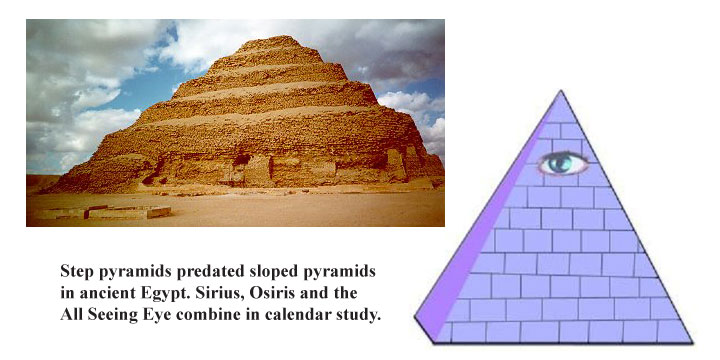
Civilization at this early juncture is virtually
impossible to define with specific names. Emerging groups once
occupied lands ranging from Africa to the Nile region and south to
the Indus Valley. Neolithic Age archeology first dates
farming communities about 9,000 BCE and gradually extends
them towards the Bronze Age 4,500 BCE period. Some people
incorporated the solar-side of the calendar to more accurately
determine planting and harvesting times. Lunar/solar calendars
were the natural outgrowth, with whole numbered 29-day or
30-day months inserted to synchronize lunar and solar
sides.
Annual flooding of the Nile River delta allowed
consistent farming. Rainy seasons provided bountiful harvests that
modified lifestyles from hunter-gather, or food finder, to one
reliant upon stable agriculture. The Egyptian legend of Two
Lands: an Upper Egypt and Lower Egypt results from northern
Nile flow to the delta. Lower Egypt shared animism beliefs about
afterlife with surrounding territories. Mastabas began as burial
mounds for the wealthier class that eventually culminated in the step
pyramids of Upper Egypt. Animal zodiacs support the
idea that often portrays human bodies with animal heads.
Humans served the mortal, whereas a person's spiritual nature
ascends to a righteous place. Paternal, masculine
spirituality was associated with solar-side worship. Sun-god
Ra or Re (ray) gained prominence.
HTU_Gn5_Ages_6d_1.jpg Sphinx and Horus hawk god pictures,
Sphinx-Rt145pc.jpg, horus-hawk.jpg, Audio is HTU_Gn5_Ages_6d.mp3
2:44
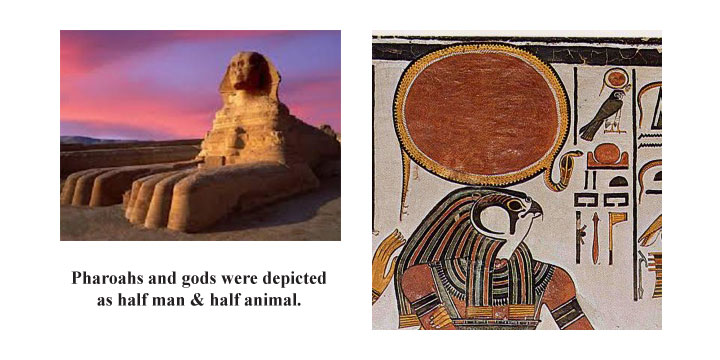
Concepts behind the god-kings later took
shape with the earliest Egyptian dynasties. Abydos in Upper
Egypt was the main religious center. Kingship acquired
divine status while deities such as Seth, Horus, Isis and
Osiris were objectives of idol worship. The famous Sphinx
portrays Pharaoh’s head on a lion body. Horus has a hawk or falcon
head on a man. A trend to replace lunar-side spiritualism
with masculine Seth, or feminine Isis for Venus, began by
2100 BCE and the Middle Kingdom. Egypt rose to be a dominant power
under the Pharaohs. Temples and pyramids attest their
architectural skills. Egypt grew in governmental stature,
including both theocracy and exalted priestly class. Calendar
scribes recorded lifetime events by writing something to the
effect: “In the umpity-ump year of the reign of king
so-and-so, something big happened.”
The Antediluvian Patriarchs bore characteristics of a half-human,
half-deity role. Like people today, they had mortal flesh
and spirit within a single body. Let's look ahead in traditional
scripture to find out more about the Patriarch Enoch. Enoch
embodies flesh and spirit in noteworthy fashion. Jewish sages hold
that Enoch was mortal, fleshly and therefore corruptible
during his first 65-year primary age (Genesis 5:21-23).
Methuselah is born and Enoch continues to live a
righteous lifestyle for his next, secondary age
300-years. We add these two ages to get Enoch's 365-year
summary age and combine discussion with the all-important 364-day-Ethiopic-year.
Enoch's special 364-day-Ethiopic-year was a solar
year with Hebrew traits. Contention occurred between those
practicing lunar-side intercalary months and those reckoning
solar-side equinoxes and solstices. Mobile groups chose the former
method while fixed locale inhabitants chose the latter. Observing
planet Venus also enters the mix since the ageless 5-pointed
star habitually follows a nearly perfect 8-solar-year
pattern. This is the 2,920-day Venus Cycle.
5-pointed star picture venusmotion67pc.jpg 0:20, repeat movie
7.25% speed reduction 1:00
plus HTU_6_LSTS400Y_1.gif 1:43, Audio is HTU_Gn5_Ages_6e.mp3
3:04
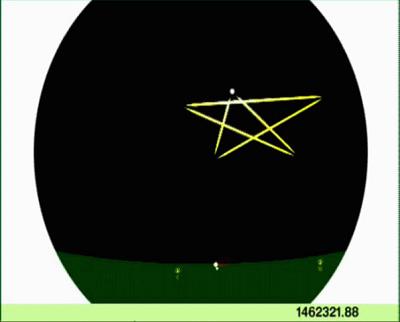 Some bright
soul realized that counting 8-solar-years by 13 different
times enabled their group to extend the calendar to 104-solar-years.
Given that Venus was considered a wandering star, this
procedure tied together nicely with 19-year and 20-year
lunar/solar cycles. All the remaining background stars in
heaven repeat their positions after the lunar/solar cycle.
Somebody then began figuring 20 times a 20-year lunar/solar
cycle resulted in 400-solar-years. They too realized
the stars had reset again to nearly their same, original places
after 400-solar-years. All together 400-solar-years had
elapsed for every solar-side 104-year Venus Round.
Mathematical squaring of time occurs when a 20-year
lunar/solar cycle is multiplied by itself. Day to year numerical
matching changes X-days of solar-side time split into X-years of
solar-solar time split. Substitution principles then permit
solar-side Venus Rounds to stand for 400-solar-years of
the squared lunar/solar cycle.
Some bright
soul realized that counting 8-solar-years by 13 different
times enabled their group to extend the calendar to 104-solar-years.
Given that Venus was considered a wandering star, this
procedure tied together nicely with 19-year and 20-year
lunar/solar cycles. All the remaining background stars in
heaven repeat their positions after the lunar/solar cycle.
Somebody then began figuring 20 times a 20-year lunar/solar
cycle resulted in 400-solar-years. They too realized
the stars had reset again to nearly their same, original places
after 400-solar-years. All together 400-solar-years had
elapsed for every solar-side 104-year Venus Round.
Mathematical squaring of time occurs when a 20-year
lunar/solar cycle is multiplied by itself. Day to year numerical
matching changes X-days of solar-side time split into X-years of
solar-solar time split. Substitution principles then permit
solar-side Venus Rounds to stand for 400-solar-years of
the squared lunar/solar cycle.
Solar-side Venus Rounds come in two versions: 104-year Venus
Rounds are based upon Mayan and Egyptian Calendars, and 105-year
Venus Rounds comprise the early Ethiopic Jewish Calendar.
My work here is largely supplemented by the Book of Enoch,
which contributes some very old and sacred information. We can
explore books like this later. For now, I want to show how the 364-day-Ethiopic-year
connects with the Jewish Ethiopic 105-year Venus Round
solar-side time split. Biblical Seth ventures so
extremely far back into absolute chronology, we can virtually
touch our earliest ancestors.
The 364-day-Ethiopic-year offers a solution that enables day-to-year
numerical matching. The Holy One adds one
whole year to the Venus Round. Individual 364-day-Ethiopic-years
were sustained. The solar-side time split lasting one 105-year
Venus Round for each 400-year lunar/solar cycle numerically
matches from dividing 210-years of lunar/solar separation time by
two. There are 105-days of solar-side time split for
each 20-year lunar/solar cycle and 105-years of solar-side time
split for each 400-year lunar/solar cycle.
Standup
HTU_Gn5_Ages_6_Close.mpg, with chroma keyed against white
background, Audio included 0:27
Timeemits' next video tells
more about Seth/Isis worship of Venus and relevant
Egyptian changes. Mythology and customs carry the Venus Round
to the Americas. Five special holidays in the solar-year help
define the Mayan calendar. We learn what the Bible has
to say about Venus. Thanks and Stay tuned.
tags Seth, mythology,
Bible, Venus, Isis, Enoch, Osiris, Jewish, Mayan, calendar, solar,
Ethiopia, Africa, Ancient, Egypt
Clark Nelson is webmaster for http://timeemits.com/Get_More_Time.htm,
author of Ages_of_Adam
and sequel, Holy_of_Holies.
Revised Copyright 2014
All Rights Reserved. URL http://timeemits.com/Scripts/HTU_Gn_5_Ages_6_Script.html
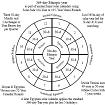 364-Day Calendar Year
364-Day Calendar Year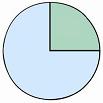 Primary_65-Ethiopic-Year_Age_of_Enoch
Primary_65-Ethiopic-Year_Age_of_Enoch
 Hi, this is How
to Understand Genesis 5 Ages, number 6 in the video series.
My name is Clark Nelson and I am going to detail the
Ethiopian religious base that was influencing early Judaism during
the Antediluvian era. Most everyone in distant prehistory
recognized an original 360-day length of year. Central
360-day calendar years are the core mainline time stream
that still exists between lunar-years and solar-years. Five days (5-days)
add with 360-days to get a typical 365-day-solar-year.
On the opposite side, lunar-years count 12-moon-months to
reach a nominal 354-day or 355-day lunar-year. Ancient
people chose whole number integer values. Lunar-years
subtract from 360-days to reveal a bisected kind of
lunar/solar year.
Hi, this is How
to Understand Genesis 5 Ages, number 6 in the video series.
My name is Clark Nelson and I am going to detail the
Ethiopian religious base that was influencing early Judaism during
the Antediluvian era. Most everyone in distant prehistory
recognized an original 360-day length of year. Central
360-day calendar years are the core mainline time stream
that still exists between lunar-years and solar-years. Five days (5-days)
add with 360-days to get a typical 365-day-solar-year.
On the opposite side, lunar-years count 12-moon-months to
reach a nominal 354-day or 355-day lunar-year. Ancient
people chose whole number integer values. Lunar-years
subtract from 360-days to reveal a bisected kind of
lunar/solar year. Early
indications of a single, omnipotent God overseeing
structured time is apparent. All four of the chieftain officers
were seen as angelic star presence subservient to the Holy One.
Specific instructions were given to omit the last 365th-day
from the regular length of year. Day-to-year numerical
matching might be an overwhelming concept at first. I need
to distinguish the special, very ancient 364-day-Ethiopic-year
from the modern 365-day-solar-year used by Ethiopia as a
country. Timeemits uses the hyphenated phrase 364-day-Ethiopic-year
for text and graphics.
Early
indications of a single, omnipotent God overseeing
structured time is apparent. All four of the chieftain officers
were seen as angelic star presence subservient to the Holy One.
Specific instructions were given to omit the last 365th-day
from the regular length of year. Day-to-year numerical
matching might be an overwhelming concept at first. I need
to distinguish the special, very ancient 364-day-Ethiopic-year
from the modern 365-day-solar-year used by Ethiopia as a
country. Timeemits uses the hyphenated phrase 364-day-Ethiopic-year
for text and graphics. Holy One sentiment
confirms a delicate balance was achieved by purposely not
counting the last, 365th-day of the year. The spirit we
traditionally call God, in this case, is off the table.
The final day simply does not exist and must not be included in
the regular computation of the year. No picture or graven image is
even possible, let alone any sound or name to apply. We might
somehow visualize an empty hole in black space. Try explaining
that! No such thing as negative time can exist for us. You are
observing a minute of time intentionally left blank in His
honor.
Holy One sentiment
confirms a delicate balance was achieved by purposely not
counting the last, 365th-day of the year. The spirit we
traditionally call God, in this case, is off the table.
The final day simply does not exist and must not be included in
the regular computation of the year. No picture or graven image is
even possible, let alone any sound or name to apply. We might
somehow visualize an empty hole in black space. Try explaining
that! No such thing as negative time can exist for us. You are
observing a minute of time intentionally left blank in His
honor. Switch over to the positive
side. OK, our last final day of the solar-year is 24-hours
long. Describe this time. What color is it? Is it bigger than a
breadbox? Can anybody hear it? Time is like the wind; we know not
where it comes from nor where it goes. So it is with divine spirit
of the Holy One (See John 3:8).
Switch over to the positive
side. OK, our last final day of the solar-year is 24-hours
long. Describe this time. What color is it? Is it bigger than a
breadbox? Can anybody hear it? Time is like the wind; we know not
where it comes from nor where it goes. So it is with divine spirit
of the Holy One (See John 3:8).

 Some bright
soul realized that counting 8-solar-years by 13 different
times enabled their group to extend the calendar to 104-solar-years.
Given that Venus was considered a wandering star, this
procedure tied together nicely with 19-year and 20-year
lunar/solar cycles. All the remaining background stars in
heaven repeat their positions after the lunar/solar cycle.
Somebody then began figuring 20 times a 20-year lunar/solar
cycle resulted in 400-solar-years. They too realized
the stars had reset again to nearly their same, original places
after 400-solar-years. All together 400-solar-years had
elapsed for every solar-side 104-year Venus Round.
Mathematical squaring of time occurs when a 20-year
lunar/solar cycle is multiplied by itself. Day to year numerical
matching changes X-days of solar-side time split into X-years of
solar-solar time split. Substitution principles then permit
solar-side Venus Rounds to stand for 400-solar-years of
the squared lunar/solar cycle.
Some bright
soul realized that counting 8-solar-years by 13 different
times enabled their group to extend the calendar to 104-solar-years.
Given that Venus was considered a wandering star, this
procedure tied together nicely with 19-year and 20-year
lunar/solar cycles. All the remaining background stars in
heaven repeat their positions after the lunar/solar cycle.
Somebody then began figuring 20 times a 20-year lunar/solar
cycle resulted in 400-solar-years. They too realized
the stars had reset again to nearly their same, original places
after 400-solar-years. All together 400-solar-years had
elapsed for every solar-side 104-year Venus Round.
Mathematical squaring of time occurs when a 20-year
lunar/solar cycle is multiplied by itself. Day to year numerical
matching changes X-days of solar-side time split into X-years of
solar-solar time split. Substitution principles then permit
solar-side Venus Rounds to stand for 400-solar-years of
the squared lunar/solar cycle.